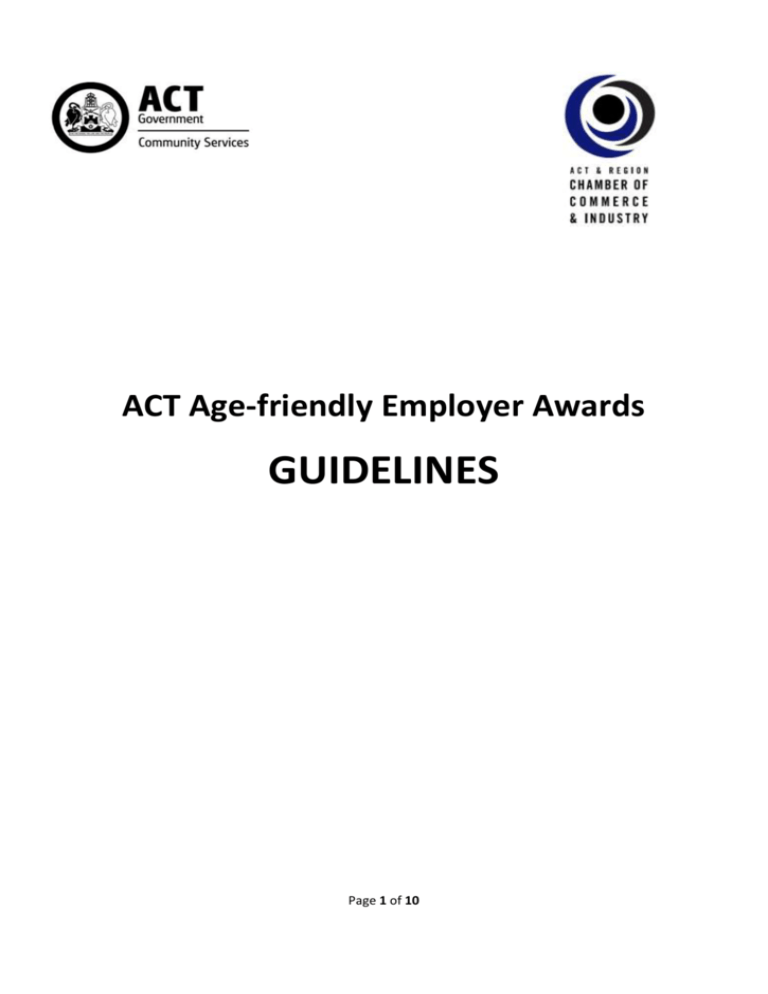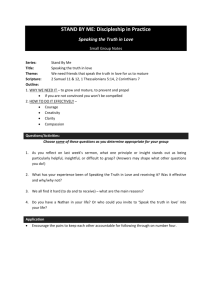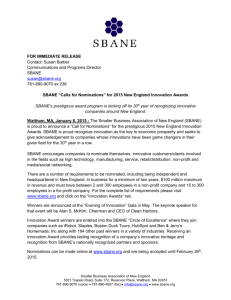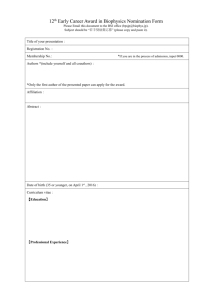Age-friendly Employer Awards - Community Services
advertisement

ACT Age-friendly Employer Awards GUIDELINES Page 1 of 10 Table of Contents Introduction ............................................................................................................................................ 3 Eligibility .................................................................................................................................................. 3 Selection Criteria ..................................................................................................................................... 4 Assessment process ................................................................................................................................ 4 Why nominate?....................................................................................................................................... 5 Timeline................................................................................................................................................... 5 Lodgment of nomination forms .............................................................................................................. 5 Nomination validity................................................................................................................................. 6 Assistance with submissions ................................................................................................................... 6 Terms and conditions.............................................................................................................................. 6 References .............................................................................................................................................. 7 Accessibility ............................................................................................................................................. 7 APPENDIX A: Examples of Age-friendly employer practices ................................................................... 8 Page 2 of 10 Introduction The long-term success of any business depends on the ability to tap into a diverse body of talent, knowledge and skills. With the maturing of the Australian population, older workers are becoming the fastest growing segment of the workforce and many intend to continue to work well past the traditional retirement age as full or part time workers. It is important to create age friendly workplaces with practices that ‘optimise the talents of older workers and create environments that capitalise on age-diverse workforces in order to grow and thrive.’1 Today’s older workers offer the benefit of experience and expertise, and as a group are considered by managers and HR professionals as highly motivated and responsible, and generally more reliable, loyal, and superior in interpersonal and communication skills than younger workers.2 Using their considerable skills in workplace mentoring programs can save your business money by reducing staff turnover, offering training to other employees and increasing staff morale. Additionally, older workers can relate well to the growing base of older customers.3 The ACT Age-friendly Employer Awards highlight the positive contribution older workers make to the workplace and recognise employers that create a workplace environment that encourages and retains older workers (50+), and raise community awareness of the benefits of older workers. Policies and practices that benefit older workers also have a positive impact on other workers and can enhance business success. Eligibility The Awards are open to all ACT employers. There are separate award categories for small employers (1-19 employees) and larger employers (20+ employees). The business must have been in operation for at least six months and must be operational at the time of the presentation of the award. Nominees must be businesses with an Australian Business number (ABN) offering goods or services for sale. 1 Finkelstein, R et al. (2012). Age-Smart Employer NYC: Compendium of strategies and practices, New York Academy of Medicine, New York. Retrieved from http://www.nyam.org/age-smart-employer/documents/ASE_Compendium.pdf 2 Johnson, R. W. (2007). Managerial attitudes towards older workers: A review of the evidence. The Retirement Policy Program Discussion Paper 08-04, The Urban Institute: Washington, D.C. Retrieved from http://www.urban.org/uploadedPDF/411705_aging_boomers.pdf 3 Economist Intelligence Unit. (2011). A silver opportunity? Rising longevity and its implications for business. Retrieved from http://longevity.axa.com/pdf/AVIVA_Axa_Longevity_GB_Web.pdf Page 3 of 10 Businesses that have been found to be in breach of ACT or Commonwealth law, the Human Rights Act 2004 (ACT) or Discrimination Act 1991 (ACT) will be excluded. Employers may apply, or be nominated by employees or customers. Mature age workers are defined as being 50 years of age or older for the purposes of this award. Selection Criteria Nominations will be considered on how well a business demonstrates that their workplace optimises the talent of older workers and creates environments that capitalise on age-diverse workforces, while meeting both business and employee goals. An applicant’s age-friendly practices can occur either informally (but can be documented) or as part of a formalised program or policy. Strategies to achieve an Age-friendly workplace address but are not limited to the following objectives: Effectively recruit mature age workers; Demonstrate strategies for retaining mature age workers by: o Actively supporting and providing opportunities for mature age workers including training, education and career development; o Offering flexible work options such as job sharing, part-time employment, leave arrangements for caring responsibilities; Promote meaningful and streamlined transitions from work to retirement. There is no expectation that applicants will meet all objectives. The goal of the Age-friendly Employer Awards is to identify and promote innovative strategies employers use in the ACT to create Age-friendly workplaces. Assessment process Nominations will be judged against the Selection Criteria by a judging panel that includes representatives from business, community and government. Employees may be interviewed about the age-friendly workplace practices and organisational culture outlined in the initial application. Judges cannot be nominated for an award and are required to declare conflicts of interest. Winners will be honoured at an awards ceremony at the ACT and Region Chamber of Commerce and Industry Annual Dinner on 21 May 2014. Page 4 of 10 Why nominate? The Award winner will receive: On year’s Annual membership to the ACT and Region Chamber of Commerce and Industry for small employers (1-19 employees) or an equivalent contribution to one year’s Annual membership to the ACT and Region Chamber of Commerce and Industry for large employers (20+ employees); A professional development course with the Chamber (for one person); A framed Award certificate for display in their premises; Dinner and admission for four people to the ACT and Region Chamber of Commerce and Industry Annual Dinner; Recognition in local media and on the Chamber of Commerce website; Use of 2014 Age-friendly Employer Award Winner logo; and Opportunity to showcase your business to your peers. Timeline Nominations open: 3 March 2014 Nominations close: 14 April 2014 Awardees Honoured: 21 May 2014 Lodgment of nomination forms Nominations forms should be submitted online at www.communityservices.act.gov.au/wac/ageing/act-age-friendly-awards by 14 April 2014. Nominees are encouraged to provide supporting material with their submission, which may include: testimonials, photos, and newspaper clippings, audio visual and other relevant material. Where it is not convenient to produce supporting documentation in digital format, post to: ACT Age-friendly Employer Awards c/- ACT Office for Ageing GPO Box 158 CANBERRA ACT 2601 Online and postal nominations will receive a return confirmation notice within five business days of receipt. If you do not receive a confirmation notice, please contact the ACT Office for Ageing at communitypolicy@act.gov.au or at 6207 6138 before 14 April 2014. Page 5 of 10 Nomination validity To be valid, submissions must: Be provided with the knowledge and agreement of the nominee. Be lodged no later than 5pm on 14 April 2014. Include a signed declaration of agreement to the conditions (page 5 of the nomination form document). Comply with the published award eligibility, guidelines and conditions of entry. Assistance with submissions If you require assistance in the preparation of submissions or have any questions regarding any aspect of these awards, please contact the ACT Office for Ageing at communitypolicy@act.gov.au or at 6207 6138 before 14 April 2014. Terms and conditions 1. The judges’ decision will be final and no correspondence or discussion will be entered into. 2. In lodging a nomination for the Age-Friendly Employer Award, the businesses and individuals submitting give permission for the ACT Government and ACT Region Chamber of Commerce and Industry to publish details of the entry for the purpose of promoting these Awards. 3. Any photographic film, either still or motion will remain the property of the ACT Government and ACT Region Chamber of Commerce and Industry who shall have free and full rights to use the name, photograph or film or recommendation of any nominee for the purposes of promoting the Awards or active ageing initiatives. 4. Businesses lodging an award submission agree to be available for the Awards Ceremony on 21 May 2014. 5. Entry into the ACT Age-friendly Employer Awards constitutes acceptance of all terms and conditions. 6. By lodging this submission the nominee affirms that the nominee has not been found to be in breach of Human Rights legislation or currently disputing a claim under this legislation. 7. The ACT Government and the Awards Coordinator will not be responsible for the improper delivery or non-arrival of awards material. Page 6 of 10 References 1. AARP (2013). AARP Best Employers for Workers Over 50. Retrieved from http://www.aarp.org/work/employee-benefits/info-092009/about_the_best_employers_program.html 2. Economist Intelligence Unit. (2011). A silver opportunity? Rising longevity and its implications for business. Retrieved from http://longevity.axa.com/pdf/AVIVA_Axa_Longevity_GB_Web.pdf 3. Finkelstein, R et al. (2012). Age-Smart Employer NYC: Compendium of strategies and practices, New York Academy of Medicine, New York. Retrieved from http://www.nyam.org/age-smart-employer/documents/ASE_Compendium.pdf 4. Department of Employment (2013). Benefits of Mature Age staff, Australian Government. Retrieved from http://employment.gov.au/benefits-mature-age-staff 5. New York Academy of Medicine (2014). Age-Smart Employer Competition, New York. Retrieved from http://www.nyam.org/age-smart-employer/competition.html 6. Johnson, R. W. (2007). Managerial attitudes towards older workers: A review of the evidence. The Retirement Policy Program Discussion Paper 08-04, The Urban Institute: Washington, D.C. Retrieved from http://www.urban.org/uploadedPDF/411705_aging_boomers.pdf 7. ACT Government (2011). ACT Business Guide to Mature Workers, ACT Government, Canberra ACT. 8. ACT Government (2013). ACT Chief Minister’s Inclusion Awards, ACT Government, Canberra ACT. Retrieved from http://www.inclusionawards.com.au/home/ Accessibility The ACT Government is committed to making its information, services, events and venues, accessible to as many people as possible. If you have difficulty reading a standard printed document and would like to receive this publication in an alternative format – such as large print or audio – please telephone (02) 6205 0619. If English is not your first language and you require the translating and interpreting services – please telephone 131 450. If you are deaf or hearing impaired and require the TTY typewriter service– please telephone (02) 6205 0888. Page 7 of 10 APPENDIX A: Examples of Age-friendly employer practices Recruitment Develop policies to support recruiting and retaining mature workers. Adopt a broad approach to advertising including using online jobsites, major and local newspapers, industry publications, seniors’ newspapers and newsletters, seniors’ expos. Remove age barriers from job advertisements, position descriptions and duty statements; include ‘mature workers welcome’ in job postings. Remove barriers in language, processes and policies that might hinder retaining or recruiting mature aged workers. Encourage positive attitudes towards mature age workers by promoting awareness of the benefits they bring to the organisation, and by training managers and human resources personnel to identify and address misconceptions about older workers. Investigate government incentives (e.g. mature age apprenticeships). Access specialist age-friendly recruiters when outsourcing recruitment (e.g. Job Services Australia); specify that suitable mature aged workers be considered. Consider full-time, part-time and casual job-share arrangements when filling new positions. Assist older applicants with online applications if requested. Use mixed-age interview panel wherever possible to reduce the possibility of age bias and ensure that interviewers are not threatened by candidates with more experience than themselves. Provide technology training as part of the job applicant screening process, if required, to ensure access to a wide possible pool of talent. Retention Promote the value of experience in your business. Conduct a skills audit to better utilise your employee’s skills. Offer variety and challenges to keep your employees motivated. Offer personal and professional development opportunities, including redeployment. Adapt training and development materials to account for different learning styles and to suit individual and generational preferences e.g. webinars, in-person or Skype sessions, online discussion groups, job rotation and on-the-job coaching individual counselling and access to online resources. Provide extra training and re-skilling if necessary. Encourage and support further training through study leave and scholarships. Offer recognition of prior learning. Page 8 of 10 Provide training and education about age discrimination and generational differences to help identify concerns, correct misperceptions, and build age-inclusive work relationships. Provide management training that acknowledges age-diversity and supports the managing of a multigenerational workforce. Support opportunities for older workers to transfer skills and knowledge and mentor other employees. Identify opportunities to accommodate older workers and improve their productivity by modifying the design of equipment or work environment (e.g. appropriate lighting, reduced ambient noise, high contrast signage, and universal design to provide optimal accessibility and usability). Access available financial and other incentives such as the Adult Australian Apprentices payment initiative and the Australian Government’s “Experience +” program which can provide assistance to employers as well as mature age workers and job seekers. For more information visit: www.deewr.gov.au/experience Offer programs that encourage health and wellbeing. Ensure workplace social activities are inclusive of older workers. Develop age-related and cross-generational employee resource groups to empower employees of all ages, promote cross-generational relationships, and establish age diversity as an organisational value. Develop and implement an anti-discrimination policy to make it clear that you do not tolerate discrimination on any basis, including age. Stay in touch with employees who have retired from your business. Should you be shortstaffed in the future, their knowledge of your business could be invaluable. Flexible work environment Investigate and trial non-traditional work structures for your employees, including part time and flexible working hours (shorter hours, different start and finish times), casual work, jobsharing, job swaps, telecommuting, or working occasionally or regularly from home. Amend roles/job design. Offer flexible leave options such as additional unpaid or purchased leave or extended leave without pay for valued staff members to travel or pursue other interests, rather than forcing them to resign and losing them. Offer a caregiver support program that allows older workers to take leave to look after frail parents, partners or grandchildren in their care (e.g. grandparent and carer leave, resources and referral services, support for dependent care, respite reimbursements, online resources and end-of-life support). Sponsor employee caregiver networks and/or support groups. Establish a culture of flexibility, in which managers routinely educate the workforce about flex options, and ensure that utilisation of flex options is not perceived as damaging to job security or career prospects. Page 9 of 10 Transition to retirement Conduct a needs assessment to identify current and anticipated needs for financial and retirement planning. Offer phased retirement/reduced work schedules. Alert mature aged staff to benefits and entitlements e.g. the ATO Mature Age Worker Tax Offset and the Centrelink Age Pension Work Bonus. Offer financial planning and advice on retirement options. Use exit interviews to ask retiring workers how they think your business could better attract and retain mature workers. Provide post retirement opportunities to utilise the skills and expertise of retired employees on short term projects or on an as needed basis. Page 10 of 10





